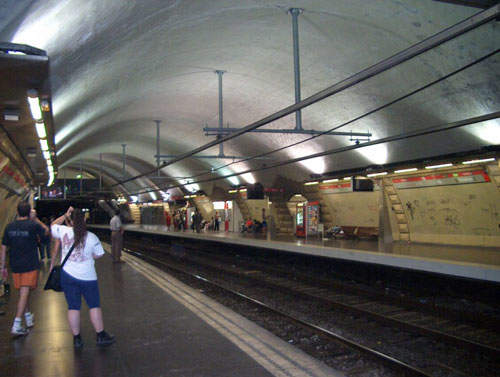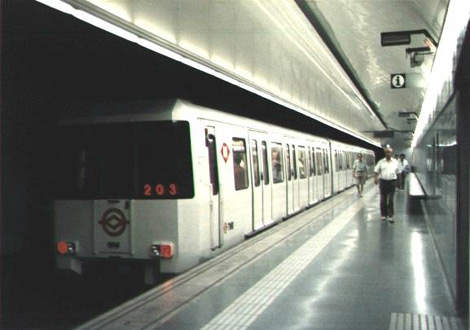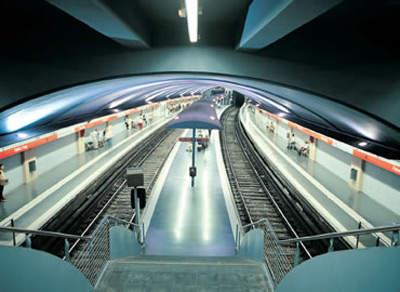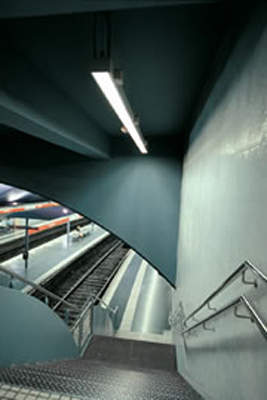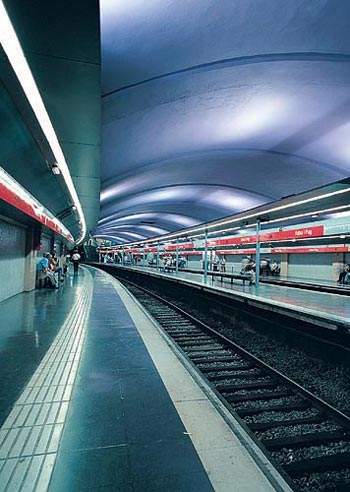In May 1999 a new plan for metro and light rail lines in the Barcelona metropolitan area was approved by the ATM. The plan included 50km of new lines, intended to be built within ten years.
A very similar plan was approved in 1971 for the period up to 1979 to create a network of 111km and 142 stations. After several extensions, the Barcelona Metro had reached 125km with 11 lines and 166 stations by September 2011.
This time it would appear the politicians mean business and there will be a vast expansion of the network to cover the urban expanse of Barcelona. The metro is moving ahead with new projects, the most ambitious of which are the proposed lines 9, 12 and 13.
At 47.8km and 55 stations, Line 9 (L9) will be the longest tube line in Europe, stretching between Santa Colomna and the El Prat International Airport.
At 60m underground, it will also be Barcelona’s deepest track. The line supports an automated train driving system. The Line 9 is under construction. Some sections of the L9 have been operating since December 2009 with five stations in the Santa Coloma de Gramenet suburb. The €6.5bn Line 9 is due to be fully operational by 2014.
Similar projects to automate lines two and 11 were undertaken and the initial tests to check the viability of the automation system on line 2 was completed in March 2008.
Line 12, although not as long or as deep, is to provide a vital link between Barcelona and the nearby town of Castelldelfels, extending peripheral Barcelona even further. It is planned for completion in 2015.
Design features of the Barcelona Metro system
The Barcelona Metro system has been designed with complete accessibility in mind. The already completed lines two and 11 link the street with the entrance hall, and lifts have been provided to allow people with mobility problems, the elderly, or those with children or luggage to easily access the station’s entrance hall.
Ergonomic devices fitted to the ticket dispensers enable less-mobile or people in wheelchairs to purchase travelcards. The navigation system fitted in these machines can also guide blind and partially sighted people through voice and Braille serigraphy throughout the purchasing process.
The train and the platform are maintained at the same level for ease of access. The platform floors have been furnished with special marks in the form of raised lines to help blind and partially sighted people to move autonomously along the station.
Barcelona’s public transport history
The evolution experienced by the public transport network in Barcelona has taken place in a parallel manner to the urban growth of the area and has furthermore adapted itself or promoted the expansion of the built-up spaces.
Since the launch of the first tramway line, in 1872, the public transport in Barcelona has gone through several phases. The metro was born from the need to complement the existing road transport network in the city. In 1908 there were tunnels built above Via Layetana.
However, it was not until 1924 that the first metro line was inaugurated. Today the Barcelona Metro has 11 lines in service, 166 subway stations and 125km of track (two whole new lines are being constructed and four others are being extended).
Its rolling stock is made up of 105 five-carriage trains, of which 93 are, unlike the London Underground, equipped with air conditioning. TMB (Transports Metropolitans de Barcelona) is the corporation that manages 86% of the public transport system.
LAMP lighting
One of the most important utilities in the Barcelona Metro has to be the efficient lighting system.
LAMP is a well-known Spanish company that specialises in architectural and commercial lighting systems.
The company has provided lighting equipment to the Barcelona Metro for a number of years and by lighting several kilometres of tunnels, corridors, halls and staircases has contributed to the metro’s enviable record of safety and growth.
In a zone with such definite characteristics such as the metro, the task is not just about providing accurate and correct lighting for all the areas, but rather about integrating all the elements of the installation in a single lighting: cables, emergencies, connections and protection devices.
Barcelona Metro lighting installation
The installation of lighting systems in an environment such as the metro requires that the materials and equipment used be of the best quality since maintenance and repair must be kept to a minimum.
The electrical conduit system consists of single piece extrusion profile, which prevents water from entering from above.
The power system also includes electrical mains for services and for emergency lighting. The lighting system itself incorporates symmetric and asymmetric optics protected by residual current protective devices.
The cabling, as per safety standard, is coated with Atumex material, which will offer burn protection in the event of a fire in the underground section of the metro and also prevent the fire from expanding and prevent the production of toxic gases.
Luminaire BCN with louvre diffuser
BCN lighting has been adapted to the urban quality and nature of the metro. It has been blended with the subway’s structure and contributes to enhance its functional character.
BCN suspended direct lighting luminaire is a modular system ideal for use in such a large system as the metro.
The units are constructed in extruded anodised matt silver aluminium and incorporate trunking and covers to house electrical service conduits.
The lights also include bright aluminium reflectors and anti-vandal louvres. The light fittings can accommodate one or two 18W, 36W or 58W T-8 fluorescent lamps.
The Barcelona Metro called for a tough luminaire, which included a variety of applications, such as integrated emergency units and options for creating flat figures.
It can, at the same time, house hidden low-voltage electrical cabling, separating the luminaires into different channels for independent operation.

